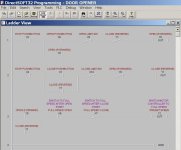Hi All:
I just found this site, and it seems great!
I have been tasked with coming up with a way to repair a small custom controller for one of our customers. The controller uses a Koyo DL105 to control a DC motor controller, which opens a set of millwork doors that cover a projection screen.
Everything seems to work except for the DL105. When 120VAC power is applied, no lights are lit, and there is no response to any of the dry contacts on the inputs.
I thought it might be something simple, so I opened up the DL105, and started tracing the power supply circuitry. I discovered that there is a 10 ohm resistor in series with L1 power lead, which was open. I replaced the resistor, but the unit still does not power up-I have done a little bit more circuit tracing, and it appears that here is a small analog power supply on the board-but the transformer seems to be open as well.
I am pretty much resigned to purchasing a new DL105 as well as the programming software, but since my company was not the one who originally built and programmed the controller, I am not sure how it was set up to run-and the customer is no help in this instance.
I am wondering if i can somehow try to pull the program out of this DL105. I thought of maybe disconnecting the onboard power supply(probably by pulling the regulator off the board) and applying an external 5V DC supply in it;s place(all of the chips on the board appear to be 5V supply). Then, if the program didn't get whacked by whatever took out the power supply, I thought I could save the existing program.
Does anyone have any thoughts on this?
Andy
I just found this site, and it seems great!
I have been tasked with coming up with a way to repair a small custom controller for one of our customers. The controller uses a Koyo DL105 to control a DC motor controller, which opens a set of millwork doors that cover a projection screen.
Everything seems to work except for the DL105. When 120VAC power is applied, no lights are lit, and there is no response to any of the dry contacts on the inputs.
I thought it might be something simple, so I opened up the DL105, and started tracing the power supply circuitry. I discovered that there is a 10 ohm resistor in series with L1 power lead, which was open. I replaced the resistor, but the unit still does not power up-I have done a little bit more circuit tracing, and it appears that here is a small analog power supply on the board-but the transformer seems to be open as well.
I am pretty much resigned to purchasing a new DL105 as well as the programming software, but since my company was not the one who originally built and programmed the controller, I am not sure how it was set up to run-and the customer is no help in this instance.
I am wondering if i can somehow try to pull the program out of this DL105. I thought of maybe disconnecting the onboard power supply(probably by pulling the regulator off the board) and applying an external 5V DC supply in it;s place(all of the chips on the board appear to be 5V supply). Then, if the program didn't get whacked by whatever took out the power supply, I thought I could save the existing program.
Does anyone have any thoughts on this?
Andy



